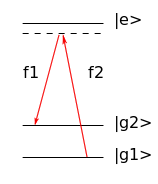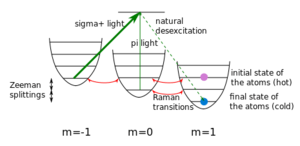Raman cooling
In atomic physics, Raman cooling is a sub-recoil cooling technique that allows the cooling of atoms using optical methods below the limitations of Doppler cooling, Doppler cooling being limited by the recoil energy of a photon given to an atom. This scheme can be performed in simple optical molasses or in molasses where an optical lattice has been superimposed, which are called respectively free space Raman cooling [1] and Raman side-band cooling.[2] Both techniques make use of Raman scattering of laser light by the atoms.
Two photon Raman process

The transition between two hyperfine states of the atom can be triggered by two laser beams: the first beam excites the atom to a virtual excited state (for example because its frequency is lower than the real transition frequency), and the second beam deexcites the atom to the other hyperfine level. The frequency difference of the two beams is exactly equal to the transition frequency between the two hyperfine levels.
The illustration of this process is shown in the schematic illustration of a two-photon Raman process. It enables the transition between the two levels and . The intermediate, virtual level is represented by the dashed line, and is red-detuned with respect to the real excited level, . The frequency difference here matches exactly the energy difference between and .
Free space Raman cooling
In this scheme, a pre-cooled cloud of atoms (whose temperature is of a few tens of microkelvins) undergoes a series of pulses of Raman-like processes. The beams are counterpropagating, and their frequencies are just as what has been described above, except that the frequency is now slightly red-detuned (detuning ) with respect to its normal value. Thus, atoms moving towards the source of the laser 2 with a sufficient velocity will be resonant with the Raman pulses, thanks to the Doppler effect. They will be excited to the state, and get a momentum kick decreasing the modulus of their velocity.
If the propagation directions of the two lasers are interchanged, then the atoms moving in the opposite direction will be excited and get the momentum kick that will decrease the modulus of their velocities. By regularly exchanging the lasers propagating directions and varying the detuning , one can manage to have all atoms for which the initial velocity satisfies in the state , while the atoms such that are still in the state. A new beam is then switched on, whose frequency is exactly the transition frequency between and . This will optically pump the atoms from the state to the state, and the velocities will be randomized by this process, such that a fraction of the atoms in will acquire a velocity .
By repeating this process several times (eight in the original paper, see references), the temperature of the cloud can be lowered to less than a microkelvin.
Raman side-band cooling

This cooling scheme starts from atoms in a magneto-optical trap. An optical lattice is then ramped up, such that an important fraction of the atoms are trapped. If the lasers of the lattice are powerful enough, each site can be modelled as a harmonic trap. Since the atoms are not in their ground state, they will be trapped in one of the excited levels of the harmonic oscillator. The aim of Raman side-band cooling is to put the atoms into the ground state of the harmonic potential in the lattice site.
We consider a two level atom, the ground state of which has a quantum number of F=1, such that it is three-fold degenerate with m=-1, 0 or 1. A magnetic field is added, which lifts the degeneracy in m due to the Zeeman effect. Its value is exactly tuned such that the Zeeman splitting between m=-1 and m=0 and between m=0 and m=1 is equal to the spacing of two levels in the harmonic potential created by the lattice.
By means of Raman processes, an atom can be transferred to a state where the magnetic moment has decreased by one and the vibrational state has also decreased by one (red arrows on the picture). After that the atoms which are in the lowest vibrational state of the lattice potential (but with ) are optically pumped to the m=1 state (role of the and light beams). Since the temperature of the atoms is low enough with respect to the pumping beam frequencies, the atom is very likely not to change its vibrational state during the pumping process. Thus it ends up in a lower vibrational state, which is how it is cooled. In order to reach this efficient transfer to the lower vibrational state at each step, the parameters of the laser, i.e. power and timing, should be carefully tuned. In general, these parameters are different for different vibrational states because the strength of the coupling (Rabi frequency) depends on the vibrational level. Additional complication to this naive picture arises from the recoil of photons, which drive this transition. The last complication can be generally avoided by performing cooling in a so-called Lamb Dicke regime. In this regime the atom is trapped so strongly in the optical lattice that it effectively does not change its momentum due to the photon recoils. The situation is similar to the Mössbauer effect.
This cooling scheme allows one to obtain a rather high density of atoms at a low temperature, using only optical techniques. Recent experiments have shown it is even sufficient to attain for example Bose–Einstein condensation.[3] For instance, the Bose–Einstein condensation of cesium has been achieved for the first time in an experiment that used Raman side-band cooling as its first step.[4]
References
- Kasevich, Mark; Chu, Steven (1992-09-21). "Laser cooling below a photon recoil with three-level atoms". Physical Review Letters. American Physical Society (APS). 69 (12): 1741–1744. doi:10.1103/physrevlett.69.1741. ISSN 0031-9007.
- Kerman, Andrew J.; Vuletić, Vladan; Chin, Cheng; Chu, Steven (2000-01-17). "Beyond Optical Molasses: 3D Raman Sideband Cooling of Atomic Cesium to High Phase-Space Density". Physical Review Letters. American Physical Society (APS). 84 (3): 439–442. doi:10.1103/physrevlett.84.439. ISSN 0031-9007.
- Hu, Jiazhong; Urvoy, Alban; Vendeiro, Zachary; Crépel, Valentin; Chen, Wenlan; Vuletić, Vladan (2017-11-23). "Creation of a Bose-condensed gas of 87Rb by laser cooling". Science. American Association for the Advancement of Science (AAAS). 358 (6366): 1078–1080. doi:10.1126/science.aan5614. ISSN 0036-8075.
- Weber, T.; Herbig, J.; Mark, M.; Nägerl, H.-C.; Grimm, R. (2002-12-05). "Bose-Einstein Condensation of Cesium". Science. American Association for the Advancement of Science (AAAS). 299 (5604): 232–235. doi:10.1126/science.1079699. ISSN 0036-8075.